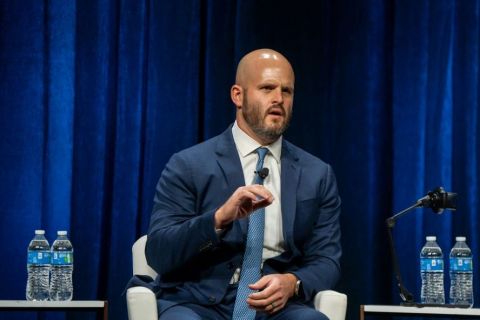Chlorine dioxide (ClO2), long used as an effective oxidizing biocide in various industries, is evolving as a go-to treatment for oilfield waters, particularly to control bacteria in fresh and produced waters that can lead to corrosion, sulfide release, fouling and environmental concerns in hydraulic fracturing operations. Yet a number of common questions persist about how it works and about its potential effects on various aspects of oilfield operations. This article attempts to answer those questions. Typical surface water applications include removal of spent polymers and gels, iron sulfide (FeS) and hydrogen sulfide (H2S) mitigation, biocide treatment of freshwater for drilling or hydraulic fracturing operations, and treatment of produced and flowback waters for reuse or disposal.
What is ClO2?
ClO2 gas is a selective oxidizing biocide that is 2.4 times heavier than air. As a dissolved gas in water, it exhibits a yellow color and has an odor similar to bleach. Solutions vary in strength. Weak solutions of less than 1 to 2 parts per million (ppm) are typically found in treated water.Safe ClO2 generation systems can create concentrated solutions of up to 3,000 ppm that can be injected into larger quantities of water such as water transfer lines or ponds. It remains a true gas in solution and does not hydrolyze with water to form other compounds.
How does ClO2 work?
ClO2 is an oxidizer that acts as both a biocide and oxidant. As a biocide, it reacts by oxidation rather than substitution; attacks the cell walls of microorganisms and interferes with protein formation; penetrates biofilm to destroy bacterial cells in the center of the colony; and rapidly and completely kills sulfate-reducing and acid-producing bacteria, even at low dosage rates.
It has gained popularity over other biocides for oilfield water treatment because it is approved by the U.S. Environmental Protection Agency (EPA) and Food and Drug Administration (FDA); it works at lower dosages; it is not affected by system pH; its corrosion rates are lower than other oxidizing biocides; it is more effective against sessile and planktonic bacteria; it does not form trihalomethanes, react with ammonia and chlorinate organics or form hypochlorous acid or free chlorine; it does not require a supplemental nonoxidizing biocide; and it is cost-competitive.
Water that has been treated with ClO2 can be used without negative impacts to hydraulic fracturing fluids, the producing formation or downhole equipment. The chemistry also acts as an FeS and H2S scavenger, helping to control issues related to corrosion and equipment fouling. Through a complex reaction, it oxidizes soluble Fe2 to Fe3, which is nonsoluble in water and will precipitate. So, although ClO2 doesn’t remove the iron, it alters its state to a form that can be removed through filtration or settling. In addition to iron, FeS and H2S, ClO2 oxidizes phenols, mercaptans and some polymers.
How is ClO2 generated and delivered?
While some “stabilized” ClO2 products come in shippable containers, these are typically chlorite-based mixtures that are enhanced when activated with acid or a low pH (acidic) environment. These products are applicable for smaller oxidative applications.
ClO2 for oilfield surface operations cannot be shipped; it must be generated near the point of application, then injected immediately into larger quantities of water. The gas is generated onsite via a mobile or permanently mounted generator using water and either a two-precursor (acid, sodium chlorite) or a three-precursor (sodium hypochlorite, hydrochloric acid, sodium chlorite) system.
Baker Hughes uses DuPont’s Chemours ADOX MG3 ClO2 generation systems in its H2PrO HD Water Management service Gen III mobile units to generate a highly effective onsite treatment solution using a proven acid/bleach system. This system is vacuum-based, requiring no pumps. Chemicals are mixed in situ in an aqueous solution at a maximum concentration level of 3,000 ppm (0.3%), eliminating any flammable hazards. This method, which is based on water flow, is considered one of the safest for generating ClO2 because it avoids potential gas formation in a prereaction chamber. If there is no water flow, no
chemical is generated.
Does ClO2 interfere with friction reducers or gels?
The degree to which pH may be decreased is highly dependent on ClO2 generation efficiency and dose rates. An inefficient reaction could leave unreacted acid in the water, and high dose rates might leave high residuals of ClO2. Under most conditions, however, there should not be any significant pH depression when using an efficient system at the proper dosage rates.
The greatest potential of lowering pH comes when treating produced waters with elevated levels of metals or FeS. Higher residual levels and lower pH can result if the dose rates are not balanced. However, when they are matched, the residual levels in the working tanks should remain low and pH relatively unchanged.
For example, in 2014 Baker Hughes treated more than 110 MMbbl of water in more than 900 wells in every major basin in the U.S. For one operator in the Eagle Ford Shale, an analysis of more than 80 wells showed the average pH of 13.5 MMbbl of
untreated water was 8.77. After treating with ClO2, the average pH of the treated water was 8.65, a drop of only 0.12. This required no changes to the operator’s standard buffer loading.
Can ClO2 decompose into O2?
The formation of O2 during treatment of water with ClO2 is not a concern in an aqueous reaction with any typical level of contamination. The oxidation reaction is kinetic, and the plethora of potential reactions greatly favors oxidation and the formation of chlorite, chlorate and subsequently chloride ions.
Is ClO2 explosive?
ClO2 is not explosive in an aqueous solution nor in a mixing system where the concentrate is never contained in a sealed tank.
Is ClO2 highly corrosive?
In-house tests of 12 common oilfield metals exposed to a 3,000-ppm solution for 24 hours at 66 C (150 F) yielded an average corrosion index below accepted standards for corrosion (0.03 lb/sq ft observed, 0.05 limit).
Does ClO2 chlorinate water?
No, it does not. The only byproduct is common table salt, which makes brine water.
Is ClO2 poisonous?
While ingestion at high levels can be hazardous, the dilution rates and application used in treating water for hydraulic fracturing minimize the risk. ClO2 is used extensively in the food preparation industry (green leafy product wash, chicken processing and raw carrot wash). It is U.S. EPA/FDA approved for food and drinking water use and is widely used in Europe in municipal water systems. It is growing rapidly in the U.S. for drinking water treatment.
ClO2-based water management systems have successfully converted a waste product into an asset for the oil field. Mitigation of long-term bacteria issues eliminates the potential for corrosion, well fouling and H2S-induced challenges. The application of ClO2, whether on-the-fly or as a prestimulation treatment, has proven to reduce operating expenses, freshwater use and safety concerns associated with produced water handling while improving the performance and efficiency of the overall operation.
Recommended Reading
Baker Hughes Awarded Saudi Pipeline Technology Contract
2024-04-23 - Baker Hughes will supply centrifugal compressors for Saudi Arabia’s new pipeline system, which aims to increase gas distribution across the kingdom and reduce carbon emissions
ProPetro Reports Material Weakness in Financial Reporting Controls
2024-03-14 - ProPetro identified a material weakness in internal controls over financial reporting, the oilfield services firm said in a filing.
Greenbacker Names New CFO, Adds Heads of Infrastructure, Capital Markets
2024-02-02 - Christopher Smith will serve as Greenbacker’s new CFO, and the power and renewable energy asset manager also added positions to head its infrastructure and capital markets efforts.
Stockholder Groups to Sell 48.5MM of Permian Resources’ Stock
2024-03-06 - A number of private equity firms will sell about 48.5 million shares of Permian Resources Corp.’s Class A common stock valued at about $764 million.
TC Energy Appoints Sean O’Donnell as Executive VP, CFO
2024-04-03 - Prior to joining TC Energy, O’Donnell worked with Quantum Capital Group for 13 years as an operating partner and served on the firm’s investment committee.





